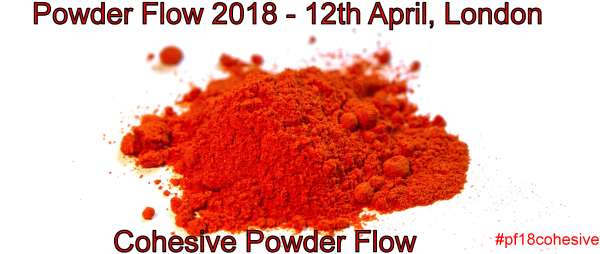
Powder Flow 2018
Cohesive Powder Flow - #pf18cohesive
The Formulation Science and Technology group (FSTG) of the Royal Society of Chemistry organised the Powder Flow meeting. This was held on Thursday 12th April 2018 at the RSC Burlington House, London.
The aim of the meeting was to provide a forum to allow leading scientists to present their work on the measurement and understanding of powder flow, with a particular look at cohesive powder flow to better understand areas such as fluidisation, aerosolisation, compaction and handling of solid particulate matter.
The meeting highlighted through both the presentations and the discussions, the advances made recently through well designed experimental measurements and creative modelling, such that many previously common powder processing problems can be predicted and suitable parameters determined to allow robust powder manufacturing. However, the analysis of even simple systems showed the complexity of real powders, which is only compounded when the powders are also cohesive. The meeting suggested that the next advances in the field will come from a closer integration of modelling, sophisticated microstructural characterisation and experimental measurements, rather than the development of more complex powder measurement tools.
The summary of the meeting is below and the programme has links to the abstracts and the presentations the speakers made at the meeting.
Speakers:
Professor Martin Rhodes, Monash University
Professor Raffaella Ocone, Heriot-Watt University
Giuseppe Forte, Johnson Matthey
Professor Charley Wu, University of Surrey
Professor Mike Bradley, University of Greenwich
Professor Mojtaba Ghadiri, University of Leeds
Dr Sina Haeri, University of Strathclyde
Dr Colin Hare, University of Surrey
Professor Brunello Formisani, University of Calabria
Tim Addison, The Centre for Process Innovation (CPI)
Organising committee
Dr Nathan Flood - Cranfield University
Professor Mojtaba Ghadiri - University of Leeds
Dr Simon Gibbon - AkzoNobel RD&I
Liz Grylls - The Centre for Process Innovation (CPI)
Dr Helen Ryder - The University of Manchester
Summary of the Meeting
The presentations and discussions during the day focussed on measuring and modelling powder flow. The challenges and possible solutions that are faced in the subject area were discussed at great length with some very interesting questions and networking taking place throughout the day. Based on feedback we hope to run the event annually.
Dr Nathan Flood opened the meeting on behalf of the RSC's Formulation Science and Technology.
The first presentation was Influence of Interparticle Forces on Powder Behaviour by Professor Martin Rhodes. It was a very good introduction to the subject of cohesive powder flow and set the scene for the days presentations. While van der Waals and electrostatic forces are always present this can be swamped by capillary forces in the presence of a liquid or just humidity, meaning that particle surface roughness can be more important to cohesiveness than particle size. Lack of control of environment resulting in changes in the dominant interparticle force accounts for much of the difficult in handling cohesive powders. Recently, understanding of the role of magnetic and friction forces have been developed. Many studies have been carried out to explain the control which interparticle forces have over the porosity of a packed powder bed, by tuning well controlled magnetic and electrostatic forces. Studies on powder flow and fluidisation have shown the control that particle density and size play in behaviour, due to the scaling of interparticle forces and stressing the importance of bond number. Despite the apparent understanding of the role of interparticle forces there are still surprises, whether it is angle of repose variations, strong effect of humidity on packing of macroscopic glass bead, the Brazil nut effect being overly sensitive to relative humidity. In conclusion there appears to be much more to learn about interparticle forces and their role in powder flow.
Professor Raffaella Ocone looked at the role of cohesion in wet particle systems. In general systems can be classified by consideration of the particle size and the dimensionless shear rate, however interpretation depends on the application. A full picture can only be built up by modelling across 7 orders of magnitude, such that a pragmatic approach is taken where having understood the pressure and shear stress in the system it is necessary to decide whether the system is in the inertial regime in which case properties are dominated by pressure and viscosity or in the quasi-static regime properties are dominated by pressure and stress ratio, to cover all these regimes and different systems, an approach of patching existing models with bolt-on additions has been found to be effective. This approach was demonstrated by consider systems in the inertial regime from dry to wet where electrical capacitance tomography was used to study experimental systems which validated the models and in the quasi-static regime comparison between shear test and DEM will be used to confirm validity.
Dr Giuseppe Forte uses the Freeman FT4 powder rheometer to assess powder blending and he described how electrical capacitance tomography (ECT) has been used to validate the insights provided by discrete element modelling (DEM) of the system. In order to successfully manufacture the mixed powder products that Johnson Matthey produces it is essential that as near perfect mixing as possible is achieved or at least that segregation of different particles is minimised. DEM is an attractive approach to understanding what is happening with powder mixtures as it is able to visualise segregation as it happens, allowing the different mechanisms to be identified, however it requires validation if such insights are to be believed. Electrical capacitance tomography gives a 3D view of what is happening within a powder bed, providing experimental proof for the relevance of DEM. The combination of rheometric measurements with DEM and ECT has allowed segregation to be studied and mechanistic insights to be validated which allow reformulation of the powder mixture to minimise segregation.
Professor Charley Wu from Surrey told us about the role of confinement in powder flow. The motivation for this study is the importance of compaction of confined powder beds in manufacturing, whether for tablets or for batteries and the subsequent failures in performance, from incorrect dose to mechanical failure which this process is prone to. A combination of DEM-CFD with experimental studies has been used to build up a model to predict successful filling parameters such that critical filling speed and deposited mass can be accurately obtained for a powder / die combination.
Professor Mike Bradley presentation (talk by Professor Mojtaba Ghadiri) was about the ambitious virtual formulation laboratory being developed as part of a collaborative EPSRC funded project to predict and optimise the manufacturability of advanced solids formulations. VFL will take as inputs molecule, particle and bulk level parameters and use these to predict flow, mixing, stability and mechanical properties. Each of the partners are addressing separate parts of the challenge: surface free energy predictions; flowability, mixing, segregation; powder compaction; particle and bulk scale measurement; material characterisation. The VFL project will develop the materials understanding to link molecules to manufacturability producing a methodology for new materials formulation which will be packaged as a software tool.
Professor Mojtaba Ghadiri from Leeds took us through powder flow issues in ADDoPT, which is UK government-industry-academia collaboration, part funded under the Advanced Manufacturing Supply Chain Initiative (AMSCI), which was instigated by the Medicines Manufacturing Industry Partnership (MMIP) which has the aim of using digital design to produce an integrated pathway from molecules to crystals to medicines. The project brings together DEM modelling and dynamic powder characterisation through the Schulz ring shear test to understand the role of cohesion, flow, particle shape and adhesion on ultimate manufacturability. The modelling has shown the strong influence of subtle changes in particle shape, i.e. between regular and truncated polyhedrons, for adhesive powders on flow and measured cohesion. It turns out that a single dimensionless number, inertial number, describes how a cohesive powder will behave as it relates the inertial timescale to the macroscopic deformation timescale. The combination of DEM and equation-based modelling has allowed the properties as measured by the Freeman FT4 to be directly related to that seen in a screw feeder. The work is proceeding with further experimental validation.
Dr Sina Haeri explained the issue of powder spreading in additive manufacture. DEM modelling if particle size and shape distribution are taken into account would provide a method to achieve far higher controllability in additive manufacturing. Once a particle bed can be produced with representative size and shape variations, then it is possible to study the impact of variation in the process parameters, spreader speed / type (blade/roller), bed thickness and aspect ratio. Important outputs such as degree of particle alignment and particle volume fraction can be studied as a function of particle shape. The work is now moving to even more realistic particle shape using a multi-sphere approximation. While the work is producing effective predictions of spreading behaviour, in order to have it adopted on the shop floor work on reduced order modelling is now planned to reduce cost.
Dr Colin Hare took a deep dive into the “simple” ball indentation tests at low stresses to understand the nature of the powder flow induced and believed to be measured. Like many simple tests the precise geometry of the system determine what the test means, so here ball diameter, bed diameter, bed depth and depth of penetration all need to be related and with a certain range in order to measure powder and not measurement system properties. The measurement of most use is unconstrained yield stress, this work compared the ball indentation test measurements to measurements made on the Freeman powder rheometer’s FT4 shear cell. The work showed that the ball indentation method was as effect as the shear cell in predicting the stick-slip behaviour and more valid at low stresses, if the constraint factor is known or can be determined. Future work will use DEM to better determine the constraint parameters as a function of particle shape and experimentally study the effect of surface, while extending to higher strain rates.
Professor Brunello Formisani focused on the use of the raining bed method to characterise cohesive powders. Powder flow is not an inherent property of any powder but is dependent on powder, flow system and environment, so the right method should be chosen dependent on the application, even better multiple measurements should be made, but currently no good connection between the different methods is available. It is important that any measurement starts with the powder in the correct consolidation state. The raining bed method is particularly appropriate for a relatively unconsolidated powder. The raining bed allows qualitative powder flow state to be assessed by visual performance of the bed, so free flowing powders rain layer by layer, cohesive powders show internal fracture of the bed with plugs breaking off in close succession. Comparison between minimum fluidisation and rain-off velocities provides a simple criterion to identify cohesive powders. Quantitative tensile strength of the particulate bulk can be determined from the deviation of the velocity ratio, which allows comparison with other tests showing lower tensile strength at low consolidation stresses. Improvements of the raining bed require better imposition and evaluation of consolidation state of the bulk powder.
Tim Addison gave an introduction to CPI, the National Formulation Centre (NFC) and its work on process analytics applicable to powder processing. NFC has been working across powder formulating industries with high throughput powder processing & scale-up, pack & fill, process analytics integration and integrating DEM and population balance models. NFC’s powder capabilities will be fully commissioned in August 2018, so is looking to collaborate with the powder formulating industries and will be holding a meeting on 16th January 2019 - “Powder Process Control”.

![]()
Exhibitors:







Sponsers:

Ecoform 2013 is a technical conference aimed to promote the exchange of information and experience among scientists and other professionals working in the field of green chemistry and formulation.
Programme will include a number of talks from invited experts from industry and academia and a selection from submitted abstracts. The speaker list includes;
• Supercritical Water - Jawwad Darr (King’s College London)
• Microwave processing – Vitaliy Khutoryanskiy (University of Reading)
• Green chemistry - Peter Dunn (Pfizer)
• Supercritical CO2 – Vivek Trivedi (University of Greenwich)
• Ultrasonics – Timothy Mason (Coventry University)
• Radiation Technology – Janusz M. Rosiak (Technical University of Łódź)
Important dates
Abstract submission: 01 March 2013
Early bird deadline: 01 May 2013
An event organised by the Formulation Science and Technology Group (FSTG) of RSC and the University of Greenwich in association with RSC Sonochemistry and Industrial Physical Chemistry group
[logos] FSTG, RSC, University of Greenwich Normal 0 false false false EN-US ZH-CN X-NONE MicrosoftInternetExplorer4
